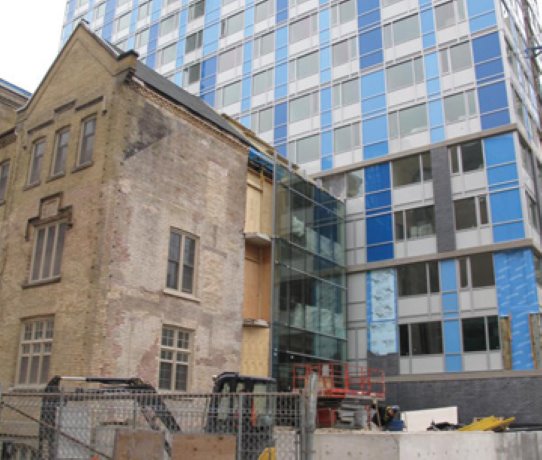At the YWCA Elm Centre in downtown Toronto, Colonial Building Restoration encountered numerous challenges in restoring the facade of a building constructed in 1848.
Masonry
Sensitively integrating all or part of an old building into new tower is often a complex and sometimes trying process for the design team.
The work doesn’t get any easier for contractors charged with preserving or restoring the existing building, especially when it is historically significant and made of materials easily damaged — but not so easily restored.
Take 163-year-old brick and limestone for example. That’s the age of the striking three-storey buff brick and stone building that fronts the new YWCA Elm Centre project in downtown Toronto.
The development — a 300-unit affordable and supportive housing project for women and women-led families — includes three new buildings, one of which rises 10 floors behind the historic building erected in 1848 to serve poor people and seniors.
The contractor restoring the old building’s façade and two sides is Colonial Building Restoration. The job, which wraps up this spring, has been anything but straightforward, largely because the building has gone through a series of renovations and additions in the 19th and 20th centuries.
One of the big hurdles for Colonial — contracted to do brick and stone repairs, cleaning and replacement of some stone and brick, repointing and new wood windows — was restoring the east- and west-facing brick façades.
Covered over by renovations, the bricks were “soiled with plaster and oil stains,” explains Andrew Lough, president of the firm.
“The problem was that in their condition, the bricks didn’t match the bricks on the front of the building.”
After carefully cleaning the old bricks, Colonial had to match the shade and color to the original brick façade. It retained Concord-based PermaTint to produce and apply a matching stain made of natural mineral silica /liquid crystals to each brick.
Cleaning buff brick is generally more difficult than the 19th century red brick commonly seen around Toronto, Lough says. The YWCA was no exception.
Generally a mild detergent in water sprayed over the bricks at low pressure (maximum 800 psi) does the trick, but for stubborn dirt the contractor used a J.O.S. system low-pressure cleaner.
Abrasive sandblasting wasn’t an option because it damages the protective outer layer of the brick (the “patina”) which prevents moisture/rain entry.
About 60 per cent of the building required repointing, a two-stage (two lift) process.
The failed lime mortar was removed to a depth of one inch and a ½-inch layer replacement was installed, then covered with burlap and kept damp for three to four days until it set before the second layer was applied, says Lough.
The two-stage process allows the mortar to set and cure gradually, preventing mortar from drying out, cracking and falling out from a rapid set.
To identify the original mortar color, Colonial evaluated areas of the exterior wall not exposed to excessive dirt or weather over the past 160 years. The best match was selected from six test mortar samples, says Lough.
To replace damaged bricks, the contractor took brick from other areas of the building — an exterior wall, for instance, where bricks had to be removed anyway for new window openings, he points out.
Making new bricks wasn’t an option. “It’s very difficult to come up with the brick formula from today’s manufacturers that would match. New brick doesn’t have the same properties (density and strength, for example) so it wears differently than old brick, which can cause future water issues and other problems.”
Many of the building’s limestone accents — mostly window sills — were beyond repair. Traditional Cut Stone made replacements which were then installed by Colonial’s tradespeople. Where sill and upper stringband damage was repairable, the damaged areas were removed and replaced with matching limestone pieces, a process called Dutchman repairs, says Lough.
Colonial expects to complete the restoration project in May or June — a job that has taken about seven months. The work, however, has been spread over a two-year period because the confined construction site presented a tricky scheduling process for the general contractor Bondfield Construction Co. Ltd. “We didn’t always have access to the tight site during construction of the tower behind us,” says Lough.
The old YWCA is designated under the Ontario Heritage Act.











Recent Comments
comments for this post are closed